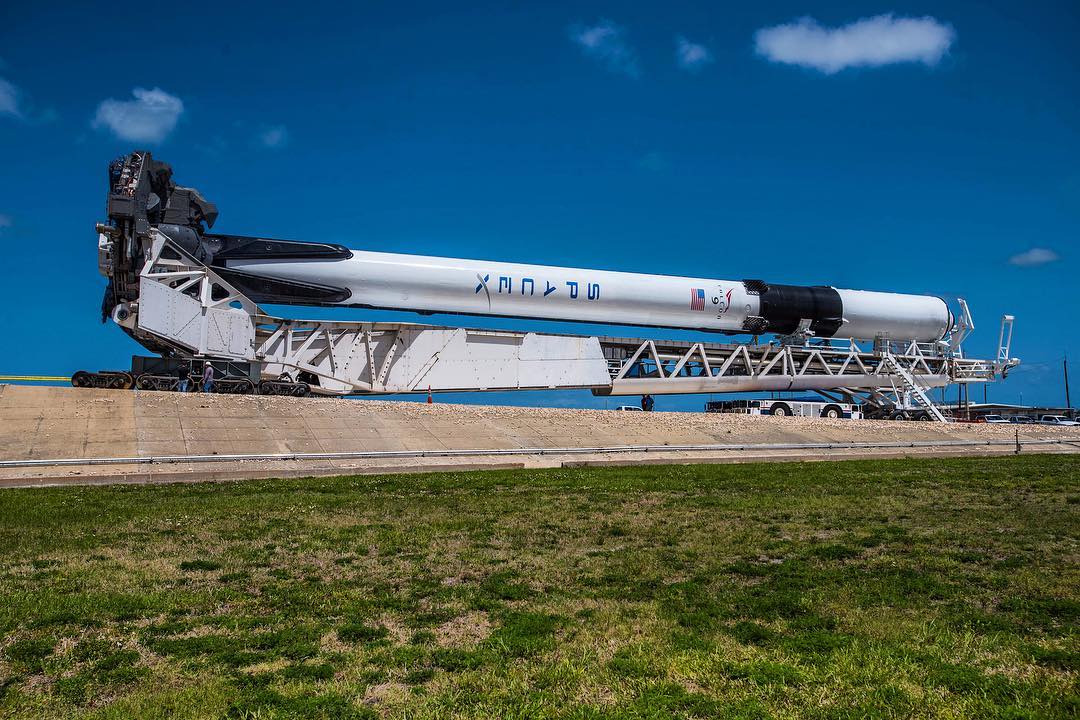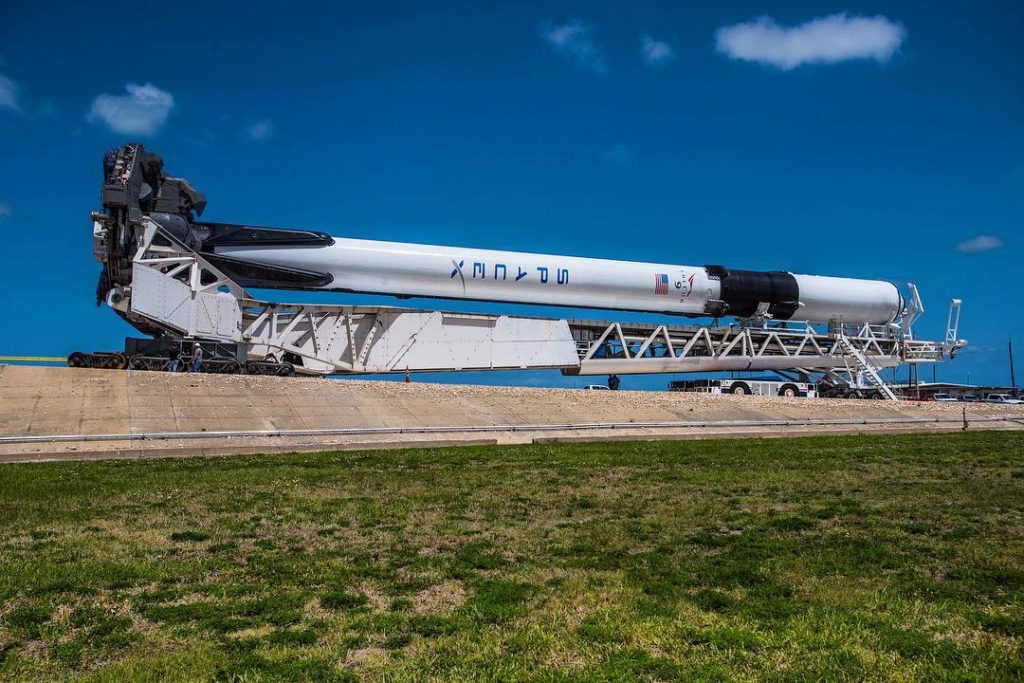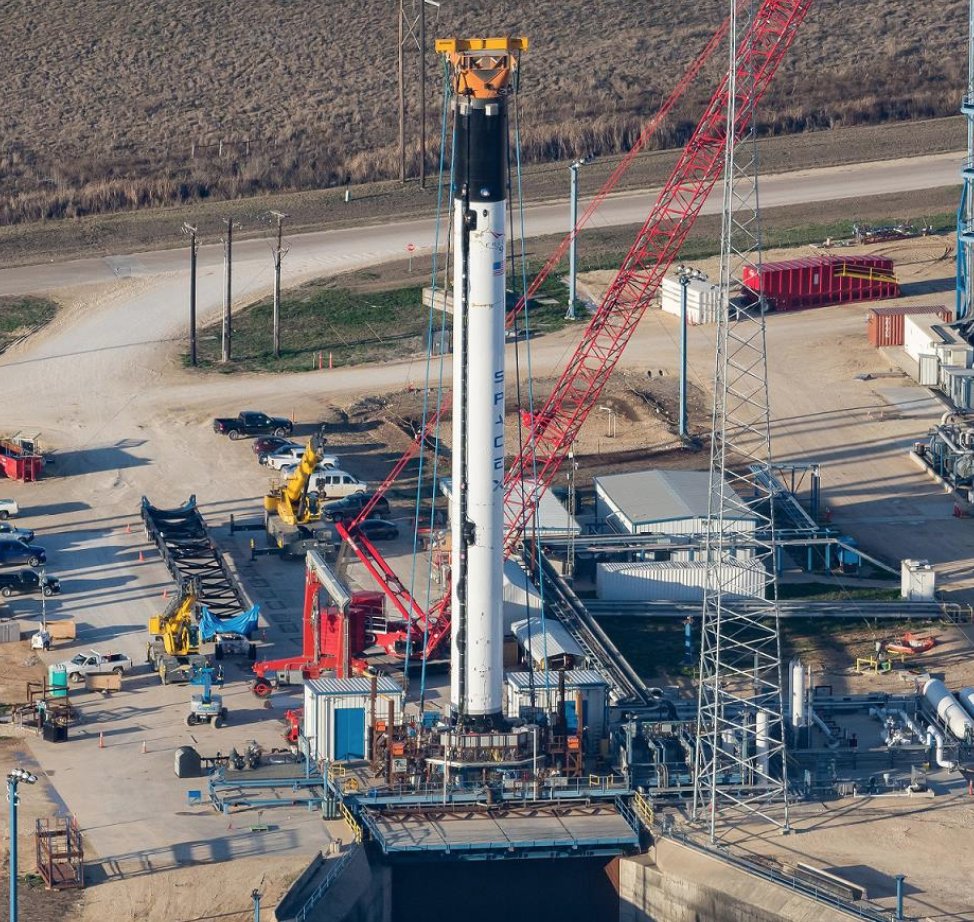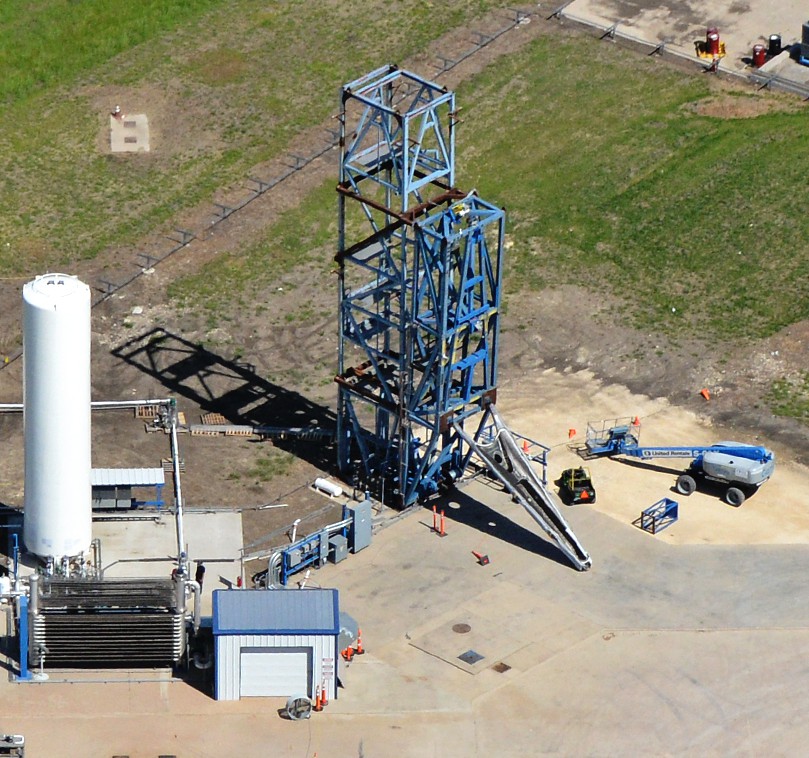

News
Elon Musk shows off SpaceX’s Falcon 9 Block 5 ahead of launch and landing debut
SpaceX CEO Elon Musk has published what appears to be the first official photo of the company’s newest Falcon 9 upgrade, known as Block 5. This particular booster is the first Falcon 9 Block 5 to be shipped to SpaceX’s launch facilities and is currently aiming for its first launch sometime next week after a May 4 static fire test, perhaps its first of anywhere from 10 to 100 operational missions.
Designed with reliability and reusability front and center, the booster upgrades have focused on additional thermal protection around the octaweb and interstage, reusable legs capable of retracting after recovery, titanium grid fins, and dramatic improvements to the heatshield at the base of the rocket. On the reliability side of upgrades, SpaceX has completed dozens of Merlin 1D static fires to qualify a turbopump redesign requested by NASA, as well as an upgraded COPV designed to guard against the type of anomaly that catastrophically destroyed Amos-6 and Falcon 9 in September 2016. A huge amount of work has also been done to improve and redesign aspects of Falcon 9 for easier (and cheaper) production and refurbishment, most notably replacing the welded octaweb structure with a bolted alternative likely to relieve many headaches and many days of octaweb weld checks.
- Falcon 9 B1046 rolled out to the launch pad for the first time ever on May 3rd, 2018. (SpaceX)
- SpaceX Block 5 Falcon9 at McGregor, Texas [Credit: Chris G – NSF via Twitter, Reprinted with permission from NASASpaceflight.com]
Aside from the biggest and most obvious changes, Block 5 is host to dozens or hundreds of additional tweaks and updates, a reflection of SpaceX’s pursuit of continuous improvement. Per SpaceX’s Vice President of Manufacturing Andy Lambert, SpaceX has “never built any two vehicles identically”, and Block 5 continues that tradition. Many Block 5 features have, however, already been flight-tested and optimized on previous Block 4 launches, including the octaweb heatshield, titanium gridfins, and minor aerodynamic tweaks to the second stage.
Block 5 sitting on the pad – harsh late day lighting [6341x 2804]
by inSpaceXLounge
The rocket is set to conduct its inaugural launch sometime next week – although the current schedule has SpaceX on May 7, Bangladeshi media have indicated that that date will slip a few days to the right after a handful of delays to the booster’s static fire. Tasked with lofting the country’s first geostationary communications satellite, Bangabandhu-1, B1046 will carry the 3500 kg spacecraft on its way to a high-energy geostationary transfer orbit before separating from the second stage and heading back to earth. The drone ship ‘Of Course I Still Love You’ and tugboat Rachel were spied departing from Port Canaveral at around the same time as Falcon 9 rolled out, and they will travel several hundred miles into the Atlantic to catch the pathfinder booster.
Tug boat Rachel has left Port Canaveral with OCISLY ahead of the SpaceX Bangabandhu mission on May 7th. The launch will be the first to feature a Block V Falcon 9.
— Michael Baylor (@MichaelBaylor_) May 3, 2018
Teslarati photographer Tom Cross will be on hand to capture the historic rocket’s static fire and launch over the next week or so, as well as the first Block 5 recovery on OCISLY if all goes as planned. Failure is always a possibility when flight-testing significantly upgraded technological systems, rockets especially, but SpaceX likely has far less tolerance for failure in the case of Block 5 – any problems with the rocket will almost invariably mothball into NASA concerns and investigations as the company nears its first crewed launches. Fingers crossed for the successful inaugural launch and landing of Falcon 9 Booster 1046.
- SpaceX’s second Falcon 9 Block 5 booster was spied by an aerial photographer in Texas, April 17. (Aero Photo)
- The same April 2018 flight captured what appears to be a Block 5 landing leg undergoing testing at a specially-designed test stand. (Aero Photo)
Follow us for live updates, behind-the-scenes sneak peeks, and a sea of beautiful photos from our East and West coast photographers.
Teslarati – Instagram – Twitter
Tom Cross – Twitter
Pauline Acalin – Twitter
Eric Ralph – Twitter

News
Tesla (TSLA) receives “Buy” rating and $551 PT from Canaccord Genuity
He also maintained a “Buy” rating for TSLA stock over the company’s improving long-term outlook, which is driven by autonomy and robotics.

Canaccord Genuity analyst George Gianarikas raised his Tesla (NASDAQ:TSLA) price target from $482 to $551. He also maintained a “Buy” rating for TSLA stock over the company’s improving long-term outlook, which is driven by autonomy and robotics.
The analyst’s updated note
Gianarikas lowered his 4Q25 delivery estimates but pointed to several positive factors in the Tesla story. He noted that EV adoption in emerging markets is gaining pace, and progress in FSD and the Robotaxi rollout in 2026 represent major upside drivers. Further progress in the Optimus program next year could also add more momentum for the electric vehicle maker.
“Overall, yes, 4Q25 delivery expectations are being revised lower. However, the reset in the US EV market is laying the groundwork for a more durable and attractive long-term demand environment.
“At the same time, EV penetration in emerging markets is accelerating, reinforcing Tesla’s potential multi‑year growth runway beyond the US. Global progress in FSD and the anticipated rollout of a larger robotaxi fleet in 2026 are increasingly important components of the Tesla equity story and could provide sentiment tailwinds,” the analyst wrote.
Tesla’s busy 2026
The upcoming year would be a busy one for Tesla, considering the company’s plans and targets. The autonomous two-seat Cybercab has been confirmed to start production sometime in Q2 2026, as per Elon Musk during the 2025 Annual Shareholder Meeting.
Apart from this, Tesla is also expected to unveil the next-generation Roadster on April 1, 2026. Tesla is also expected to start high-volume production of the Tesla Semi in Nevada next year.
Apart from vehicle launches, Tesla has expressed its intentions to significantly ramp the rollout of FSD to several regions worldwide, such as Europe. Plans are also underway to launch more Robotaxi networks in several more key areas across the United States.
News
Waymo sues Santa Monica over order to halt overnight charging sessions
In its complaint, Waymo argued that its self-driving cars’ operations do not constitute a public nuisance, and compliance with the city’s order would cause the company irreparable harm.

Waymo has filed a lawsuit against the City of Santa Monica in Los Angeles County Superior Court, seeking to block an order that requires the company to cease overnight charging at two facilities.
In its complaint, Waymo argued that its self-driving cars’ operations do not constitute a public nuisance, and compliance with the city’s order would cause the company irreparable harm.
Nuisance claims
As noted in a report from the Los Angeles Times, Waymo’s two charging sites at Euclid Street and Broadway have operated for about a year, supporting the company’s growing fleet with round-the-clock activity. Unfortunately, this has also resulted in residents in the area reportedly being unable to sleep due to incessant beeping from self-driving taxis that are moving in and out of the charging stations around the clock.
Frustrated residents have protested against the Waymos by blocking the vehicles’ paths, placing cones, and “stacking” cars to create backups. This has also resulted in multiple calls to the police.
Last month, the city issued an order to Waymo and its charging partner, Voltera, to cease overnight operations at the charging locations, stating that the self-driving vehicles’ activities at night were a public nuisance. A December 15 meeting yielded no agreement on mitigations like software rerouting. Waymo proposed changes, but the city reportedly insisted that nothing would satisfy the irate residents.
“We are disappointed that the City has chosen an adversarial path over a collaborative one. The City’s position has been to insist that no actions taken or proposed by Waymo would satisfy the complaining neighbors and therefore must be deemed insufficient,” a Waymo spokesperson stated.
Waymo pushes back
In its legal complaint, Waymo stated that its “activities at the Broadway Facilities do not constitute a public nuisance.” The company also noted that it “faces imminent and irreparable harm to its operations, employees, and customers” from the city’s order. The suit also stated that the city was fully aware that the Voltera charging sites would be operating around the clock to support Waymo’s self-driving taxis.
The company highlighted over one million trips in Santa Monica since launch, with more than 50,000 rides starting or ending there in November alone. Waymo also criticized the city for adopting a contentious strategy against businesses.
“The City of Santa Monica’s recent actions are inconsistent with its stated goal of attracting investment. At a time when the City faces a serious fiscal crisis, officials are choosing to obstruct properly permitted investment rather than fostering a ‘ready for business’ environment,” Waymo stated.
News
Tesla FSD v14.2.2 is getting rave reviews from drivers
So far, early testers have reported buttery-smooth drives with confident performance, even at night or on twisty roads.

Tesla Full Self-Driving (Supervised) v14.2.2 is receiving positive reviews from owners, with several drivers praising the build’s lack of hesitation during lane changes and its smoother decision-making, among others.
The update, which started rolling out on Monday, also adds features like dynamic arrival pin adjustment. So far, early testers have reported buttery-smooth drives with confident performance, even at night or on twisty roads.
Owners highlight major improvements
Longtime Tesla owner and FSD user @BLKMDL3 shared a detailed 10-hour impression of FSD v14.2.2, noting that the system exhibited “zero lane change hesitation” and “extremely refined” lane choices. He praised Mad Max mode’s performance, stellar parking in locations including ticket dispensers, and impressive canyon runs even in dark conditions.
Fellow FSD user Dan Burkland reported an hour of FSD v14.2.2’s nighttime driving with “zero hesitations” and “buttery smooth” confidence reminiscent of Robotaxi rides in areas such as Austin, Texas. Veteran FSD user Whole Mars Catalog also demonstrated voice navigation via Grok, while Tesla owner Devin Olsen completed a nearly two-hour drive with FSD v14.2.2 in heavy traffic and rain with strong performance.
Closer to unsupervised
FSD has been receiving rave reviews, even from Tesla’s competitors. Xpeng CEO He Xiaopeng, for one, offered fresh praise for FSD v14.2 after visiting Silicon Valley. Following extended test drives of Tesla vehicles running the latest FSD software, He stated that the system has made major strides, reinforcing his view that Tesla’s approach to autonomy is indeed the proper path towards autonomy.
According to He, Tesla’s FSD has evolved from a smooth Level 2 advanced driver assistance system into what he described as a “near-Level 4” experience in terms of capabilities. While acknowledging that areas of improvement are still present, the Xpeng CEO stated that FSD’s current iteration significantly surpasses last year’s capabilities. He also reiterated his belief that Tesla’s strategy of using the same autonomous software and hardware architecture across private vehicles and robotaxis is the right long-term approach, as it would allow users to bypass intermediate autonomy stages and move closer to Level 4 functionality.












